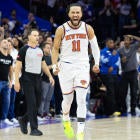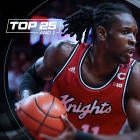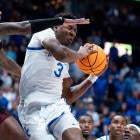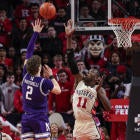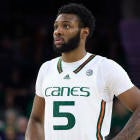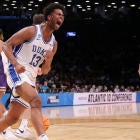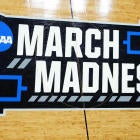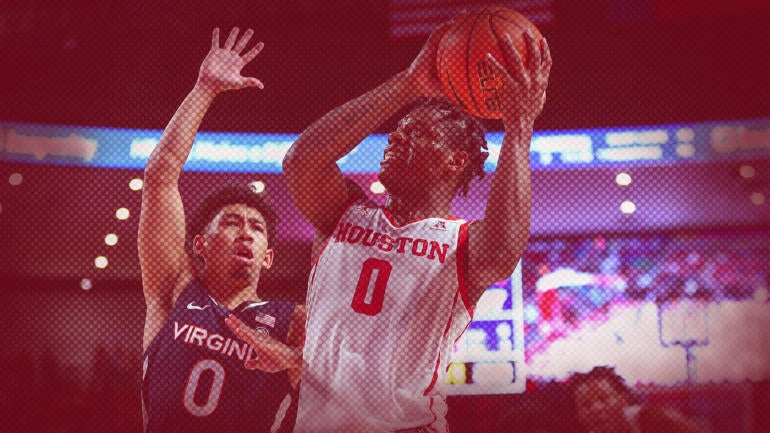
From nearly every angle you look at it, the American Athletic Conference took a step back last season propped up mostly by two NCAA Tournament teams -- Houston and Memphis -- and by a respectable SMU club. Its two teams in the Big Dance tied for the second-fewest since the league's inception, and only one of the other teams in the league (SMU) made the NIT, a result representative of just how big a dip there was from the top tier of the league to everyone else looking up at them.
The chances that's once again the case in 2022-23 aren't nothing, either. Houston looks like it'll have one of the best teams in the country because -- much to the chagrin of all non-Houston programs in the American -- Kelvin Sampson still runs the show. Memphis might've finally grabbed the final infinity stone by adding a point guard in SMU transfer Kendric Davis. Then there's Cincinnati, which under Wes Miller looks ready to be build on a sturdy foundation. There's questions about a lot of the league, but there aren't about the top of it; it should be strong once more.
What should change this year is a much-improved middle and bottom of the league, flickering a glimmer of hope that the AAC -- long considered one of the seven major conferences in college hoops -- could regain its foothold in the greater college landscape. Ron Hunter and his Tulane team should ride the wave straight to relevance this year with their trajectory ascending upward. Temple's transfer-heavy influx of talent under Aaron McKie could jolt the Owls back to life. And there's even some cautious optimism emanating out of perennial cellar-dwelling Eastern Carolina, one of three programs entering new regimes after a bustling coaching carousel saw tons of turnover.
Lost in the shuffle of the AAC discussion is of course the ratcheted-up stakes of what the AAC is now and will become soon. This is the final year of membership for Cincinnati, Houston and UCF, all Big-12 bound, so while the league may exist in some form, its makeup after this year will look quite a bit different this time next year.
Preseason Player of the Year
Marcus Sasser | SG | Houston
Sasser was pacing towards All-American status last season with Houston until a season-ending injury cut short his breakout year just before he became a household name. Houston rebounded remarkably, finishing 32-6 and advancing to the Elite Eight with a litany of injuries, but Sasser back at full strength gives Cougars fans permission to dream as big as possible. He'll be one of the most prolific scorers in the country on a Houston team that has had a top-10 offense and a top-10 defense each of the last two seasons.
Four more players to watch
Kendric Davis | PG | Memphis: Davis is the highest profile intra-conference transfer within the AAC. The reigning AAC Player of the Year heads to Memphis where he gives Penny Hardaway his most talented point guard since he took over the Tigers program.
Jamal Shead | PG | Houston: On a Cougars team loaded with talent on both ends, Shead is the glue that holds it all together. The third-year point guard is the catalyst on offense and an ever-present force on defense.
Jalen Cook | PG | Tulane: A former LSU transfer, Cook finished second among all AAC players in points per game in his first season last year with Tulane. He's one of five returning starters for the Green Wave in 2022-23 and the biggest reason for optimism that the program will jump back into relevance in the fourth year under Ron Hunter.
Khalif Battle | SG | Temple: Battle's 21.4 points per game last season extrapolated out for the entire season would have led all AAC players and probably put him into conference POY discussion. But he missed 22 games with injury and only competed in seven. If healthy he's one of the most gifted scorers in college basketball.
Preseason Freshman of the Year
Jarace Walker | PF | Houston
There is some debate over which Cougars player is more deserving of this honor -- GP and I are in lockstep that it should be Walker, while Matt Norlander believes it should be his teammate, Terrance Arceneaux -- but there's no debate that Houston has the best incoming talent in the league. I'm breaking the tie here and giving the nod to Walker, the highest-ranked signee in the program's history and the first five-star to sign with the school in a decade. Sampson and his staff will make Walker earn the accolades he's accumulated, and it may take some time, but eventually he's going to develop into a force on a team fit to meet his strengths as an energetic, crash-the-glass forward who plays with an edge.
Predicted order of finish
| 1 | |
| No. 1 with a bullet. In the AAC there is Houston, then there is everyone else. The Cougars bring back Jamal Shead and Reggie Chaney, get back injured stars Tramon Mark and Marcus Sasser, AND they enroll a class with two potential difference-makers in Jarace Walker and Terrance Arceneaux. The talent was already tops in the AAC, and the edge they have with the best coach in the league makes this borderline unfair. Houston could win this league by multiple games if it can stay healthy. | |
| 2 | |
| SMU transfer point guard Kendric Davis, the reigning AAC Player of the Year, gives Memphis an exciting lead guard around which to build -- a luxury Penny Hardaway has not been afforded since he's been at the helm of the Tigers program. The team has other holes to plug -- it lost Jalen Duren, Lester Quinones, Emoni Bates and other producers -- but it should be one of the more experienced teams Penny has had. With 26-year-old (!) DeAndre Williams back in the fold, they have a Perry Ellis-like stabilizer that should help set the tone in a pivotal year for Penny. | |
| 3 | |
| David DeJulius is the focal point of a really talented returning cast of characters for coach Wes Miller in his second season with the Bearcats. Cincinnati should have a much-improved defense and the continuity of a program that has been in constant turnover the last few years should help them make a leap back near the top of the league standings. Cincy may still be a year away from totally revamping itself -- it is working on a top-20 recruiting class in 2023 -- but the cohesiveness and experience of this unit should warrant serious respect as they look to return to old glory. | |
| 4 | |
| Ron Hunter of chair-falling infamy while at Georgia State enters his fourth season with Tulane as the steady rebuild has crescendoed seemingly to a spot where the Green Wave are ready to make a leap. They bring back every starter from last season and their young nucleus, led by former LSU transfer Jalen Cook, is a year older and wiser. After posting their first winning record in AAC play last season since the league's inception, they seem primed to roll into the top half of the league and push for a potential NCAA Tournament berth. | |
| 5 | |
| Temple had the second-least experienced team in the country last season according to KenPom.com's metrics yet still finished the season 17-12, this despite also losing star scorer Khalif Battle after playing in only seven games and the likes of Jeremiah Williams, Arashma Parks and others missing extended periods with injuries as well. Coach Aaron McKie needed some wind at his sails and entering his fourth season, he finally has some with Battle and most of the nucleus of the team still intact. It's been an uphill climb the last few years transitioning out of the Fran Dunphy era for McKie, but the pieces are in place for his rebuild to really take off this season. | |
| 6 | |
| Coach Johnny Dawkins had his most experienced roster last season since 2018-19 -- the season UCF nearly toppled Duke in the NCAA Tournament -- yet it was still something of a mystery box as to what the team would do on any given night. They finished 9-9 in AAC play and middle or just below middle of the pack in both offensive and defensive efficiency among teams within the league. The loss of their top three scorers from last season blunts the Knights' prospects, but the return of former five-star C.J. Walker combined with a few additions out of the transfer portal is keeping them in the mix to be a top-half-of-the-league finisher. | |
| 7 | |
| Isaac Brown had a dream season serving as Wichita State's interim coach in 2020-21, taking the team to the NCAA Tournament and earning the role full-time. The honeymoon period was abrupt, though, as the Shockers went 15-13 overall last season and 6-9 in league play in what was a down year for the AAC. The offseason wasn't kind, either: star Tyson Etienne turned pro and seven players transferred out, forcing Brown into a major roster overhaul. There's likely some significant challenges in the short-term that'll come with so much turnover. | |
| 8 | |
| Brian Gregory hasn't had a winning season since 2018-19, his second season at South Florida, so the seat is getting a touch warm as he enters his sixth season. The Bulls were bad last year when they were second to last in the entire country in effective field goal percentage but the addition of Memphis transfer Tyler Harris should raise the floor and give this team a steadying veteran presence. | |
| 9 | |
| SMU is one of three AAC programs who underwent offseason coaching changes -- and all three rank last in our projected standings for next season. New coach Rob Lanier did well for himself at Georgia State but inherits a roster that lost leading scorer Kendric Davis and its top three scorers overall. The long-term outlook for this program is strong, but the short-term forecast is cloudy with a strong chance of growing pains. | |
| 10 | |
| After a 20-loss season -- its most losses in a season in nearly two decades -- and a decline in fan morale, Tulsa moved on from longtime coach Frank Haith and poached Erik Konkol from Louisiana Tech. Konkol inherits a roster that brings back just two players who averaged 20 or more minutes per contest last season and lost four of its five starters, so it's going to be a long road ahead. Konkol's teams at La. Tech had a habit of doing more with less so TU could be a pest, but it'll be nothing more than that as he builds back this program. | |
| 11 | |
| Long-time Rick Barnes assistant Michael Schwartz takes over at ECU in his first head coaching job, but does so at a program that has finished last or next-to-last in five of the eight seasons it has been in the AAC (including four of the last five seasons). This is one of the toughest jobs and toughest rebuilds in all of college hoops. Schwartz will build with toughness on the defensive end, where he specialized at Tennessee, but with the top six scorers from last season gone, he's effectively starting from scratch. | |
Most overrated team
Temple
Temple got one vote from our panel as the No. 4 team in the league and settled on average at No. 5 in our preseason poll, so perhaps the "overrated" tag is a bit harsh -- I have them at No. 6. But after finishing fourth in the league last season, Cincinnati and Tulane appear destined to make a leap and Houston, Memphis and SMU aren't going anywhere. The return of Khalif Battle makes the Owls a bit of a wild card with lots of upside, but it feels a bit like they could take a step back in the arms race of the league with so many other teams set to make a leap.
Most underrated team
Cincinnati
Despite stumbling to the finish line with eight losses in its last 10 games -- no, more like face-planting on the asphalt and army-crawling to the finish line -- optimism surrounding Cincinnati's prospects in Year Two under Wes Miller are sky-high. The team brings back most of its core from a squad that made major strides from the season prior. With six of its top seven scorers returning, including star David DeJulius, and a complementary incoming class led by Memphis transfer Landers Nolley, the Bearcats have the goods to go from bottom half of the league standings to challenging for the No. 2 spot behind Houston and very possibly a bid to the Big Dance to boot.





























